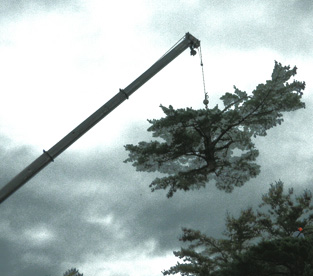
The tree was not on our property; it was on the neighbor’s property. But to all of us in the neighborhood, the large pine tree that was in their back yard between their house and the water of Lake Boon always drew our attention and admiration whenever our gaze was drawn to that side of the lake.
It was perfectly organized with sturdy straight branches and its height proudly reached 80’ into the clouds and provided welcome shade to all those sitting under it. The tree had been doing this for over 100 years. In fact, many of the kids in the neighborhood had opportunities to swing on tires attached to the lower branches of the tree, and as they grew older would swing from long ropes tied to the upper branches that allowed them to swing high over the edge of the property into the lake’s waters with lots of squeals and laughter.
In the early part of the 1800s, the northern section of the Lake Boon area around Pine Point Road and Barton Road was all farmland. In fact, there was no Lake Boon, just a much smaller Boon’s Pond surrounded by several large farms where, like most farms in Stow, the land was cleared of trees to plant crops.
 When the woolen mill in Maynard needed a more reliable water flow from the Assabet River to power their mill, the mill owner dammed up the outlet from Boon’s pond that ran into the river, forming Lake Boon whose waters were used to increase the flow of the Assabet River when required. When the mill converted to electricity in the late 1800s for power, the lake water was no longer needed, and the lake stayed at the level of the Barton Road dam.
When the woolen mill in Maynard needed a more reliable water flow from the Assabet River to power their mill, the mill owner dammed up the outlet from Boon’s pond that ran into the river, forming Lake Boon whose waters were used to increase the flow of the Assabet River when required. When the mill converted to electricity in the late 1800s for power, the lake water was no longer needed, and the lake stayed at the level of the Barton Road dam.
The farmers then switched their crop from corn to campers, who found the lake attractive and wanted to rent or build cottages by its shore. Without the farmers tending their fields, the fields started to quickly sprout trees, the most common and fastest growing of which were pine trees.
Pine trees, if given enough water, can grow 1 to 2 feet per year. Our neighbor’s tree was probably planted when the house was built and its age can be determined by counting the rings in a cross section of the tree’s trunk when it is cut down. According to the rings, this tree was about 110 years old.
I woke up one morning and found our road blocked off and occupied by several large trucks and an impressively large giant crane. The pine tree was too large for equipment big enough to handle the tree to get there from the road. So they cut the tree into 8 foot sections lifting each section high up into the sky over top of the 40’ house and even higher power lines, then down onto waiting trucks. This scene seems to be happening a lot all around town.
Yes, some of the trees being removed are dead and others threaten houses if blown over by strong winds. At least such trees are being fully recycled with branches being reduced to wood chips to be used elsewhere and straight trunk sections being cut up into lumber to lead a different life. But still, I feel like I’m witnessing an important part of that house’s history being removed forever.